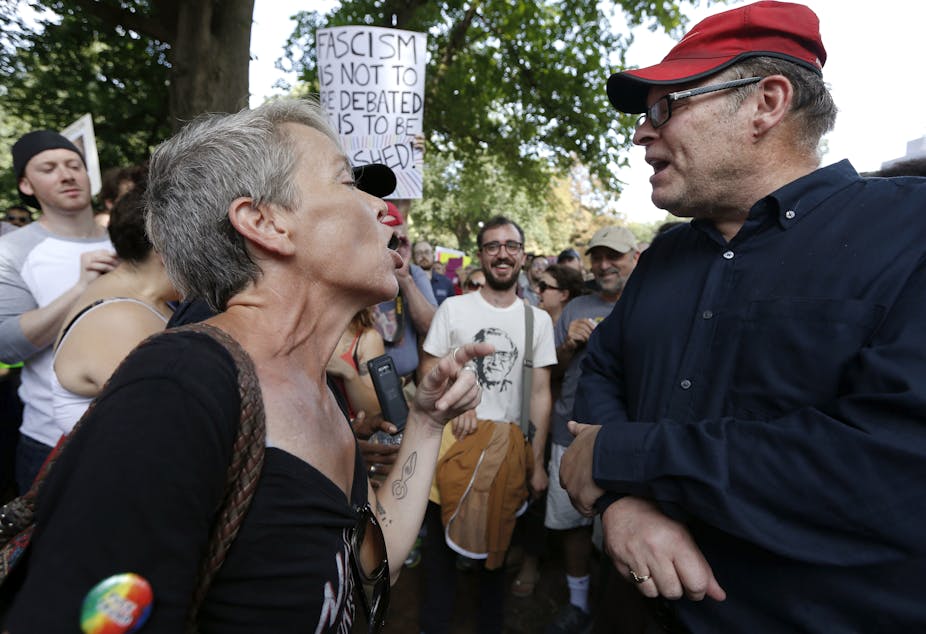There are those who say that comparing President Donald Trump’s rhetoric to that of Adolf Hitler is alarmist, unfair and counterproductive.
And yet, there has been no dearth of such comparisons since the 2016 presidential election. Many commentators have also drawn parallels between the conduct of Trump supporters and Holocaust-era Nazis.
The comparisons continue today, and Trump’s comments in the wake of the Charlottesville attack show why. The president’s reference to violence on “both sides” implies moral equivalence, which is a familiar rhetorical strategy for signaling support to violent groups. His comments give white supremacists and neo-Nazis the implied approval of the president of the United States.
Many of these groups explicitly seek to eliminate from the U.S. African-Americans, Jews, immigrants and other groups, and are willing to do so through violence. As co-directors of Binghamton University’s Institute for Genocide and Mass Atrocity Prevention, we emphasize the importance of recognizing and responding to early warning signs of genocide and atrocity crimes. Usually, government officials, scholars and nongovernmental organizations look for these warning signs in other parts of the world – Syria, Sudan or Burma.
Has the time come to watch for these warning signs in the United States?
Is it possible in the US?
The term “genocide” invokes images of gas chambers the Nazis used to exterminate Jews during World War II, the Khmer Rouge killing fields of Cambodia and thousands of Tutsi bodies in the Kagera River in Rwanda. On that scale and in that manner, genocide is highly unlikely in the United States.
But genocidal violence can happen in the U.S. It has happened. Organized policies passed by elected U.S. lawmakers have targeted both Native Americans and African-Americans. The threat of genocide is present wherever a country’s political leadership tolerates or even encourages acts with an intent to destroy a racial, ethnic, national or religious group, whether in whole or in part.
The Holocaust took the international community by surprise. In hindsight, there were many signs. In fact, scholars have learned a great deal about the danger signals for the risk of large-scale violence against vulnerable groups.
In 1996, the founder and first president of the U.S.-based advocacy group Genocide Watch, Gregory H. Stanton, introduced a model that identified eight stages – later increased to 10 – that societies frequently pass through on the way to genocidal violence. Stanton’s model has its critics. Like any such model, it can’t be applied in all cases and can’t predict the future. But it has been influential in our understanding of the sources of mass violence in Rwanda, Burma, Syria and other nations.
The 10 stages of genocide
The early stages of Stanton’s model include “classification” and “symbolization.” These are processes in which groups of people are saddled with labels or imagined characteristics that encourage active discrimination. These stages emphasize “us versus them” thinking, and define a group as “the other.”
As Stanton makes clear, these processes are universally human. They do not necessarily result in a progression toward mass violence. But they prepare the ground for the next stages: active “discrimination,” “dehumanization,” “organization” and “polarization.” These middle stages may be warning signs of an increasing risk of large-scale violence.
Where are we now?
Trump’s political rhetoric helped propel him into office by playing on the fears and resentments of the electorate. He labeled out-groups, hinted at dark conspiracies, winked at violence and appealed to nativist and nationalist sentiments. He has demanded discriminatory policies including travel restrictions and gender-based exclusions.
Classification, symbolization, discrimination and dehumanization of Muslims, Mexicans, African-Americans, the media and even the political opposition may be leading to polarization, stage six of Stanton’s model.
Stanton writes that polarization further drives wedges between social groups through extremism. Hate groups find an opening to send messages that further dehumanize and demonize targeted groups. Political moderates are edged out of the political arena, and extremist groups attempt to move from the former political fringes into mainstream politics.
Do Trump’s implied claims of a moral equivalence between neo-Nazis and counterprotesters in Charlottesville move us closer to the stage of polarization?
Certainly, there are reasons for deep concern. Moral equivalence – the claim that when both “sides” in a conflict use similar tactics, then one “side” must be as morally good or bad as the other – is what logicians call an informal fallacy. Philosophers take their red pens to student essays that commit it. But when a president is called on to address his nation in times of political turmoil, the claim of moral equivalence is a lot more than an undergraduate mistake. We suggest this is a deliberate effort to polarize, and an invitation to what comes after polarization.
Responding and preventing
Polarization is a warning of the increased risk of violence, not a guarantee. Stanton’s model also argues that every stage offers opportunities for prevention. Extremist groups can have their financial assets frozen. Hate crimes and hate atrocities can be more consistently investigated and prosecuted. Moderate politicians, human rights activists, representatives of threatened groups and members of the independent media can be provided increased security.
Encouraging responses have come from the electorate, business leaders, government officials and the international community. Individuals and groups are following the recommendations for action presented in the Southern Poverty Law Center’s guide to combating hate in supporting victims, speaking up, pressuring leaders and staying engaged. Business leaders have also expressed their discontent with Trump’s polarizing statements.
Local governments are declaring themselves sanctuary cities or cities of resistance. At the national level, strong statements have been made by leaders of all of the military branches.
Several international leaders have also spoken up. German Chancellor Angela Merkel condemned the racist and far-right violence displayed in Charlottesville, and U.K. Prime Minister Theresa May harshly criticized Trump’s use of moral equivalence.
In our assessment, these actions represent essential forms of resistance to the movement toward polarization, and they reduce the risks of genocide.

